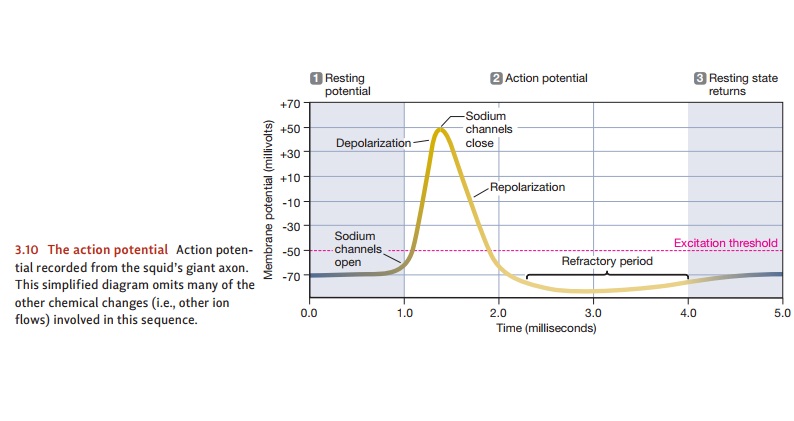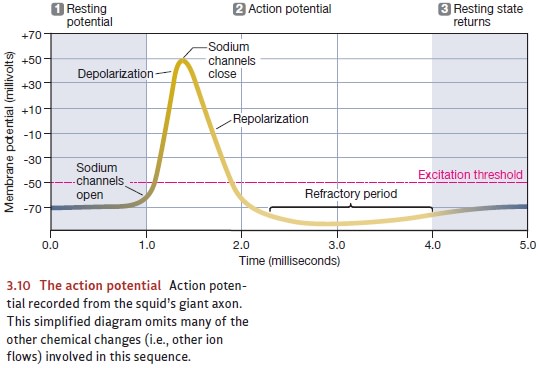Chapter: Psychology: The Brain and the Nervous System
Explaining the Action Potential

Explaining the
Action Potential
We’ve just described the action
potential in terms of electrical measurements, but what lies behind these
measurements? What is going on inside the neuron—and, crucially, at the
neuron’s cell membrane—that causes this momentary change in the neuron’s
electrical state? The answers lie in the movements of ions through the neuron’s
mem-brane. Ions are molecules (or single atoms) that have a positive or
negative electrical charge. When a neuron is at rest (i.e., not stimulated),
the inside of the cell contains both positive ions and negative ones, and the
same is true for the fluid outside the cell membrane. What’s crucial is the concentration of each ion type, and
these concentra-tions are different inside the cell than they are outside.
What governs the ion
concentrations? As one factor, the cell’s membrane contains mechanisms called ion pumps that—as their name
implies—actively pump ions into or out of the cell. For the most part, these
pumps work to move sodium (Na+) out
of the cell and potassium (K+) into
the cell, but they do so unevenly: three sodium ions move out for every two
potassium ions that move in.
In addition, the cell membrane
contains ion channels—actual
passageways through the membrane. When open, these channels allow certain ions
(but not others) simply to pass through. In other words, the channels work
roughly like bouncers at a party or a bar—they let desired guests pass through
unchallenged but block undesired visitors.
When a neuron is at rest, sodium
ions are barely able to pass through these channels, but potassium ions flow
through freely. We need to bear in mind, though, that (thanks to the ion pumps)
there are more potassium ions inside the cell than outside, and (as a general
fact of chemistry) ions tend to move from areas of higher concentration to
areas of lower concentration. Therefore, the dominant movement of potassium
through these channels is outward—out of the cell interior and into the
extracellular fluid. This creates a surplus of positive ions outside of the
cell, and this is the main source of the resting potential—again: the voltage
difference across the neuron’s membrane, with the cell interior electrically
negative relative to the cell exterior.
The situation changes
dramatically when some portion of the membrane is stimu-lated in some way
(mechanically, electrically, or chemically). In this case, a new set of ion
channels—ones that allow sodium to pass—spring open and so sodium ions flood
into the cell (Figure 3.10). This process leads to an excess of positively
charged particles on the inside of the membrane, and this is why our electrodes
detect a sudden swing toward a positive voltage. Immediately after, though, the
membrane returns to its orig-inal status: The sodium pumps resume their
evacuation of sodium to the outside of the

neuron, and the sodium channels
slam shut to keep it out. This process reestablishes the membrane’s stability and
restores the resting potential.
This restoration is fast, but it
does take a moment; and during this restoration process, there is still an
imbalance of ions. This is why, during this brief interval, it is much more
difficult to launch a new action potential. This interval is referred to as the
refractory period—the time after an
action potential during which the cell mem-brane is unprepared for the next
action potential. Once the refractory period is done, however—a time span of
just a few milliseconds—the membrane is back to its resting state and ready for
the next input.
Related Topics